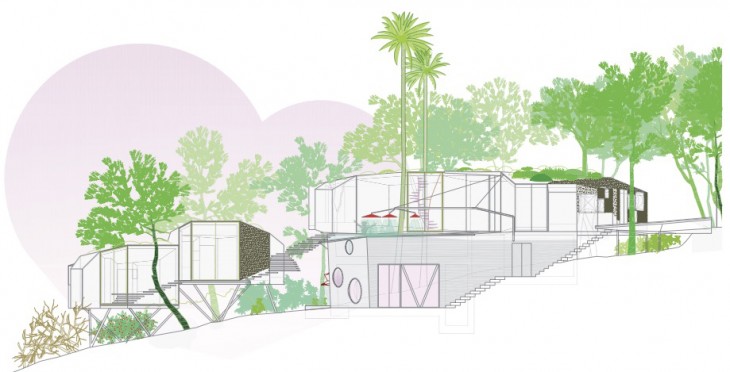The name adopted for this house on Ibiza originated with Peter Pan’s magical island where kids never grow up, and is also shared with Michael Jackson’s private amusement park: Never Never Land. A major architectural gesture for this party villa is the raising of the floor plate onto stilts, a move which both improves the view to the sea, and minimizes the disturbance to natural drainage paths down the mountain. Yet more so than environmentalism, the design of this house is driven by positional and disturbed logics. It is a chaotic mess of garish paint and ugly cladding, with multiple trees penetrating the floor and roof. One interesting aspect is how sightlines have been crafted so that you can almost – but not quite – see into the adjacent bedrooms. The importance of hedonism to inform the design is proven by the showering lady visible in the elevation above. Overall, this project sacrifices quality of layout, representation and execution of the design to present a particular ideal of “sexiness”.
In contrast, Philippe Rahm’s “Form and Function Follow Climate” argues that climate should reclaim precedent over other design considerations that have dominated architectural discourse since the advent of modernism, like program and appearance. He gives several examples of vernacular architectural spaces that were only given a function after they existed, such as the French refraichoir and Iraqi sirdar, used solely to cool their inhabitants, and the campi of Venice that were meant to collect rainwater. Consequently, these spaces have been able to adapt and also to generate new functions. The environmental logic strongly informs this text, and along with the other logics can provide a deeper understanding of what decisions should be made in architectural practice.
Another line of study that may yield interesting results for architecture – both environmentally and spatially – is the study of quantum mechanics. It is a realm of mathematics used by physicists to explain everything from fluid dynamics to why and how certain materials reflect light. Knowing what we do now about emergent behaviour, it makes sense that in order to understand relationships between large-scale forces, we must first understand small-scale interactions. Nature has the queer trait of resembling itself at all scales, whether it be atomic or galactic; cellular replication or human replication. There is much we don’t know about the construction of everything in the universe, from the molecules that form a chair, to the energies that define your self. Perhaps, by analyzing the latest developments in quantum mechanics through the perceptive lens of architecture, new connections can be found between these fields.

